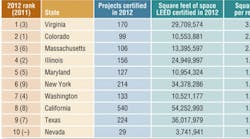Latest from Mike Weil
Can HVAC Be Fun? What About All the Eye Candy?
HVAC Water Management: Big Changes Ahead
Welcome to our new AHR Expo Insider Coverage
This is somewhat of a rhetorical question. I ask it because there is so much buzz over the importance of building performance and the need to document and certify that our commercial, industrial, and residential structures are meeting energy standards and government regulations.
I certainly am a proponent of building performance. I believe most people in the industry are, too. But then there is LEED (Leadership in Energy and Environmental Design), the de facto green-building certification standard developed by the U.S. Green Building Council (USGBC). A recent study by Turner Construction Co. shows a majority of real-estate owners, developers, and corporate owner occupants are planning new projects this year—both new construction and renovation—with the intent of making use of environmentally sustainable practices. Interestingly enough, these same respondents are not so committed to obtaining LEED certification (http://bit.ly/LessLEED).
In fact, the number of respondents saying they will seek LEED certification for their projects has been on the decline for three years running. This and many other studies show the construction industry remains concerned that the cost of such certification is too high, with too long of a payback period. They do not show that the industry is not committed to sustainability or building performance.
Many seek other types of certification to prove their buildings meet green goals. The ENERGY STAR certification program is very popular, according to the study.
In January, HPAC Engineering published an article titled “A Paler Shade of Green” by John H. Scofield (http://bit.ly/Scofield_0113). The article discusses the construction of the Adam Joseph Lewis Center for Environmental Studies at Oberlin College, which was designed to be a zero-energy building in the late 1990s. The intentions were good. The bad news is that over its first 11 years, the building failed to perform at zero-energy levels.
Study of the building’s energy use led to corrections and redesigns that resulted in 2012 being the first calendar year in which the center produced more electric energy than it consumed. However, the financial sustainability of the Adam Joseph Lewis Center model remains unclear. There were many reasons for the failure of the initial design, and the story of this seems to be far from over.
Obviously, this is a very expensive and time-consuming process. I do not believe the project was LEED-certified, although it received much notoriety for its design and proposed efficiency.
Could the certification process have uncovered the problems? Not necessarily, and therein lies the rub.
Concerns about stated energy use vs. actual energy use in the LEED process remain, and although the USGBC addressed this in the mandated energy-use requirement of LEED v3, it
isn’t retroactive, and some LEED-certified buildings remain energy hogs. Version 4, which is scheduled for review this year, may address this problem, but, right now, it remains an open question.
As an industry, I believe we have to continue working on ways to reduce the cost of green buildings, and part of those efforts should be focused on the cost of achieving certification.
I also believe it doesn’t end there. As important as certification is, it means nothing if measurement and testing aren’t performed on a regular basis to prove that a building is operating at design levels.
Is certification necessary? Yes. But building performance does not begin and end with that certification.










